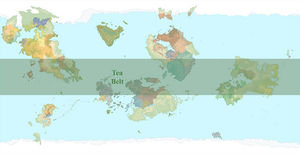Tea belt: Difference between revisions
Jump to navigation
Jump to search
Created page with "thumb|right|Tea belt The '''tea belt''' refers to the tropical and subtropical climates that {{wp|camellia sinensis}} (tea) is most commonly grown in. Some varieties can tolerate oceanic climates, but these are not often counted in the traditional sense of the tea belt as they are hybridized cultivars that are excluded from the Royal Burgoignesc Tea Processing Society's classification of ''True Teas''. ==Likely high..." Tag: 2017 source edit |
mNo edit summary Tag: 2017 source edit |
||
| Line 1: | Line 1: | ||
[[File:Tea Belt.png|thumb|right|Tea belt]] | [[File:Tea Belt.png|thumb|right|Tea belt]] | ||
The '''tea belt''' refers to the tropical and subtropical climates that {{wp|camellia sinensis}} (tea) is most commonly grown in. Some varieties can tolerate oceanic climates, but these are not often counted in the traditional sense of the tea belt as they are hybridized cultivars that are excluded from the [[Royal Burgoignesc Academies|Royal Burgoignesc Tea Processing Society]]'s classification of '' | The '''tea belt''' refers to the tropical and subtropical climates that {{wp|camellia sinensis}} (tea) is most commonly grown in. Some varieties can tolerate oceanic climates, but these are not often counted in the traditional sense of the tea belt as they are hybridized cultivars that are excluded from the [[Royal Burgoignesc Academies|Royal Burgoignesc Tea Processing Society]]'s classification of ''true teas'' ([[Burgoignesc language|Burg]]: ''tes vertadiers''). | ||
==Likely high output tea growing regions== | ==Likely high output tea growing regions== | ||
*[[Alstin]] highlands | |||
*[[Tierrador|Tierro]]-[[Ormatia]]n border highlands | |||
*Southcentral [[Tierrador]]ian highlands | |||
*[[Paulasteria]]n central highlands | |||
*Southern half of the eastern [[Carnland]] highlands | |||
*[[Yonderre|Yonderro]]-[[Anglei]] border highlands | |||
*All elevations in [[Urcea]] | |||
*[[Sacatia]]n northcentral highlands | |||
*[[Kagazi|Kagazo]]-[[Jazee]] border highlands | |||
*Southwestern [[Jazee]] highlands | |||
*[[Jazee|Jazo]]-[[Thervala]]n border highlands | |||
*All elevations in [[Thervala]] | |||
*All elevations in [[Kandara]] | |||
*Southern coastal highlands in [[Zaclaria]] | |||
*[[Kandara|Kandaro]]-[[Ankivara]] border highlands | |||
*[[Canpei]]-[[Rusana]]-[[Daxia]] border highlands | |||
*All elevations in [[Daxia]] | |||
*All elevations in [[The Holding]] | |||
*tbc | |||
==See also== | ==See also== | ||
Revision as of 15:59, 5 November 2024

The tea belt refers to the tropical and subtropical climates that camellia sinensis (tea) is most commonly grown in. Some varieties can tolerate oceanic climates, but these are not often counted in the traditional sense of the tea belt as they are hybridized cultivars that are excluded from the Royal Burgoignesc Tea Processing Society's classification of true teas (Burg: tes vertadiers).
Likely high output tea growing regions
- Alstin highlands
- Tierro-Ormatian border highlands
- Southcentral Tierradorian highlands
- Paulasterian central highlands
- Southern half of the eastern Carnland highlands
- Yonderro-Anglei border highlands
- All elevations in Urcea
- Sacatian northcentral highlands
- Kagazo-Jazee border highlands
- Southwestern Jazee highlands
- Jazo-Thervalan border highlands
- All elevations in Thervala
- All elevations in Kandara
- Southern coastal highlands in Zaclaria
- Kandaro-Ankivara border highlands
- Canpei-Rusana-Daxia border highlands
- All elevations in Daxia
- All elevations in The Holding
- tbc